
Technology
|
09 Jan 2022
蓝牙
蓝牙是一种短程无线技术,可在无许可的工业、科学和医疗 (ISM) 2.4 GHz 射频频段中运行。


在全球布署的生态系统中有强健的连接性
目前有两种蓝牙无线技术可用:用于音频和流应用的 BR/EDR(基本速率/增强数据速率)蓝牙和用于靠电池工作的传感器设备的低功耗蓝牙(BLE)。
强健性
蓝牙技术动态地调适频率跳变序列 – 利用自适应频率跳变(AFH) – 来避免信道被其他技术使用的可能。自动功率控制将输出功率降低到保持连接所需的水平,与此同时还不干扰邻近的其他 2.4 GHz 无线电(包括其他蓝牙连接)。前向纠错(FEC)使得接收机能纠正恶劣环境引入的有限比特差错。因此,蓝牙尤其适合用于工业、汽车和医疗应用,在这些应用中蓝牙所提供的可靠性至关重要。
前所未有的生态系统
市场情报研究机构 ABI Research 称,到 2021 年,启用了蓝牙的设备发货量将会超过 50 亿。的确,蓝牙已经成为移动设备之间的无线连接标准,所有的智能手机和平板均有该功能。有数以百计的智能手机和定制手提控制器应用程序被用来管理或监视具有嵌入式蓝牙的别的系统,以及用来在用户间分享媒体、文件和信息。
BR/EDR 蓝牙 vs. 低功率蓝牙
尽管 BR/EDR 蓝牙和低功率蓝牙的核心名称相同,但它们之间也有一些根本的差异。BR/EDR 蓝牙设计用于音频连接和流应用。低功率蓝牙技术非常适合用于定期传输少量数据的应用,这些应用看重的是超低的功率消耗。低功率蓝牙使用一种比 BR/EDR 蓝牙快得多的连接机制,能够把无线电接通非常短的时间。这就是为何该技术对于物联网(IoT)应用中的传感器尤其有用的缘故。
双模蓝牙设备既支持低功率蓝牙也支持 BR/EDR 蓝牙。比如在智能手机中的情况:它可以通过 BR/EDR 蓝牙与笔记本电脑连接,并通过低功率蓝牙与某个心率传感器连接。心率传感器只使用低功率蓝牙,因此是单模低功率蓝牙设备一个样例。
在低功率蓝牙中,设备有外围和中心角色。一旦建立连接后,两台设备形成与 BR/EDR 蓝牙相似的主从拓扑。在上面的例子中,心率传感器作为外围/从设备的角色,而智能手机则作为中央/主设备的角色。
设定档(profile)指的是一种规格书,描述了某种特�定的使用情况,被用来实现支持同一设定档的两种设备间的操作互通性。两台开启了 BR/EDR 蓝牙的设备需要实施了相同的设定档方可相互连接。例如,个人区域网(PAN)容许两台或更多设备形成一个即兴的(ad hoc)网络,串行端口设定档(SPP)取代了串行通信接口。
在低功率蓝牙技术中,类属性(GATT)设定档定义了一种分级数据结构,这种数据结构被用来在低功率蓝牙设备之间交换配置数据。GATT 设定档描述了使用情况,而 GATT 服务则是一些特性(数据、描述、可能的行动等),这些特性定义了低功率蓝牙设备的各种能力。
GATT 定义了 客户端(“请求数据的设备”)和服务器(“拥有数据的设备”)。服务器和客户端交换信息来建立会话,并规定有效载荷运输要求和它们的重复率或事件触发器(event triggers)。同一产品中可以同时存在两种功能:u-blox 低功率蓝牙模块(NINA B1、NINA-B3、ODIN-W2)既有 GATT 服务器又有 GATT 客户端的作用,其实现是为了提供设计灵活性。也可以规定定制服务。例如,u-blox 已经规定了 u-blox 串行端口服务,以便能在与蓝牙 EDR/BR SPP 相似的低功率蓝牙设备之间可靠地进行串行数据交换。
蓝牙 5
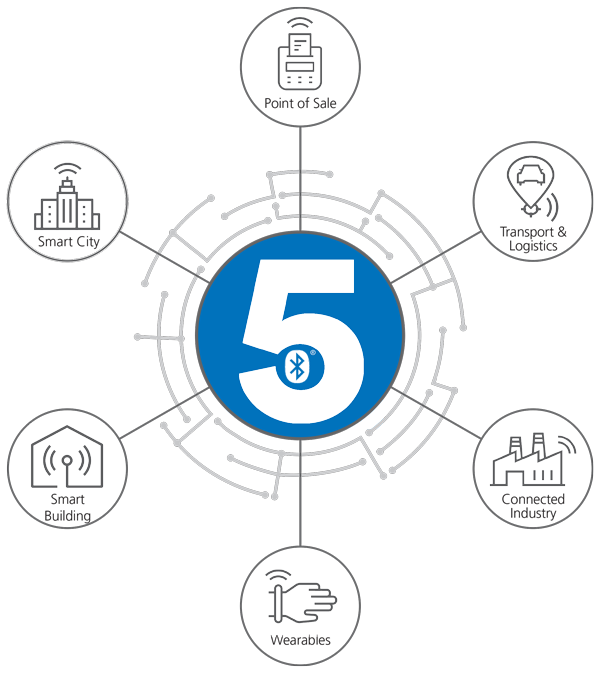
最新版本的蓝牙 5 规范纳入了对低功率蓝牙的三种主要增强:提高的数据速率(2 倍的速度),扩展的覆盖范围(4 倍的距离)以及增强的广告能力。其中�两种增强可通过软件升级实现,另一种(扩展覆盖范围)则需要新的硬件。
近来引入的蓝牙网状网络使得多对多的低功率蓝牙联网解决方案成为可能。蓝牙网状网络可以低功率蓝牙的软件升级形式获得,能够与低功率蓝牙版本 4.0、4.1、4.2 和 5.0 中之任何一种配合使用。
网状网络能显著地扩展覆盖区域,甚至比蓝牙 5 还大,因为蓝牙节点能够转发消息,起到合作性网络中网络中继器的作用。
蓝牙 5 和蓝牙网状网络为蓝牙技术开启了全新的应用。工业传感器网络、建筑自动化、街道照明、环境监视以及许多其他应用将只需要一个单一的主机节点来采集、控制和管理数据和网状网络。
各种蓝牙版本及其特点概览:
| 版本/扩展 | 特性 | 描述 |
| 蓝牙 4.1 | ||
| BR/EDR 安全连接 | 提供 128-位 AES 加密强度 | |
| 双模拓扑 | 使一台设备能同时起到蓝牙双模集线器和低功率蓝牙外围设备的作用。 | |
| L2CAP 专用信道 | 在低功率蓝牙上启用 IPv6 | |
| 蓝牙 4.2 | 互联网协议支持设定档(IPSP) | 低功率蓝牙传感器能够通过网关设备接入互联网 |
| LE Privacy 1.2 | 防止低功率蓝牙设备被追踪 | |
| LE 安全连接 | 为低功率蓝牙提供 128-位 AES 加密强度 | |
| LE 数据长度扩展 | 提高数据吞吐量最高可达 2.5 倍 | |
| 蓝牙 5 | 2 Mbps LE | 将低功率蓝牙支持的数据速率扩展最高可达 2 Mbps,从而使速度翻倍 |
| LE 远距离 | 将低功率蓝牙设备所支持的覆盖范围扩展四倍 | |
| LE 广告扩展 | 支持更长的广告消息,用于更多特色丰富的蓝牙信标和用于未来的基于 IPv6 的网状网络 | |
| 蓝牙网状网络 | LE 拓扑扩展 | 网状网络显著地扩展了合作性低功率蓝牙网络所覆盖的区域。 |

Bluetooth 5.2
Bluetooth 5.2 introduces isochronous channels, which are primarily designed to support LE Audio, the next generation of Bluetooth Audio. Several use cases are anticipated, such as music sharing, hearing aid systems, and multi-language audio systems. But the feature is also applicable in a variety of industrial applications, where sending time-synchronized data to several devices is of essence.
The new LE power control feature makes it possible for Bluetooth devices to dynamically optimize the transmission power used in communication between connected devices. The aim is to improve overall system performance as well as to reduce power consumption.
Finally the enhanced attribute protocol - EATT - supports concurrent transactions with the aim to reduce the end-to-end latency of one or more applications and speed up responsiveness to improve user experience.
Bluetooth mesh
Bluetooth mesh enables many to many network topologies using Bluetooth LE solutions. Bluetooth mesh is available as a software update to Bluetooth LE and can be used with any Bluetooth LE version (from 4.0 and beyond).
Bluetooth mesh extends the coverage area beyond that of Bluetooth 5 by letting nodes forward messages, acting as relays in a cooperative network.
Bluetooth 5 and Bluetooth mesh open up completely new applications for Bluetooth technology. Industrial sensor networks, building automation, street lighting, environmental monitoring, and many other use cases can be implemented using a single host node to collect, control, and manage data and the mesh network.
Overview of Bluetooth versions and their features
| Version/ extension | Features | Description |
| Bluetooth 4.1 | ||
| Classic Secure Connections | Provides 128-bit AES encryption strength | |
| Dual Mode Topology | Enables a device to act as a Bluetooth dual-mode hub and Bluetooth LE peripheral at the same time | |
| L2CAP Dedicated Channels | Enables IPv6 over Bluetooth LE | |
| Bluetooth 4.2 | Internet protocol support profile (IPSP) | A Bluetooth LE sensor can access the Internet through a gateway device |
| LE Privacy 1.2 | Keeps Bluetooth LE devices from being tracked | |
| LE Secure Connections | Provides 128-bit AES encryption strength for Bluetooth LE | |
| LE Data Length Extension | Increases data throughput up to 2.5x | |
| Bluetooth 5 | 2 Mbps LE | Extends the data rates supported by Bluetooth LE up to 2 Mbps, thus doubling the speed |
| LE Long Range | Extends the range supported by Bluetooth LE devices to four times the range | |
| LE Advertising Extension | Support for longer advertisement messages for more feature rich Bluetooth beacons | |
| Bluetooth mesh | LE Topography Extension | Mesh networking significantly extends the area covered by a cooperative Bluetooth LE network |
| Bluetooth 5.1 | Direction finding | Improves indoor positioning, asset tracking, proximity applications, and indoor navigation |
| Bluetooth 5.2 | Isochronous channels | Enables audio streaming and synchronized data transfer over Bluetooth LE |
| LE power control | Allows dynamic optimization of power consumption over Bluetooth LE | |
| Enhanced Attribute Protocol | Supports concurrent transactions with the aim to reduce the end-to-end latency of one or more applications and improve user experience in terms of responsiveness | |
u-blox works to deliver products with the latest technologies and ensure that its portfolio is kept up to date by delivering firmware updates whenever appropriate. Find out how to upgrade u-blox modules to the latest releases on the Product Resources page.
For more information about what u-blox can offer with Bluetooth, check out the full u-blox Bluetooth portfolio.
更多产品
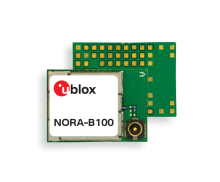
NORA-B1 系列(CPU 可运行客制化程序的)
Stand-alone 低功耗蓝牙 5.2 模块
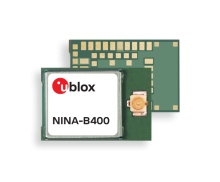
NINA-B40 系列 (open CPU)
Stand-alone 低功耗蓝牙 5.1 模块
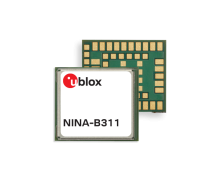
NINA-B31 系列 (u-connect)
stand-alone 低功耗蓝牙 5.0 模块
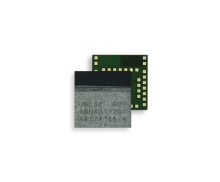
ANNA-B112 (u-connect)
独立蓝牙 5.0 低功耗模块
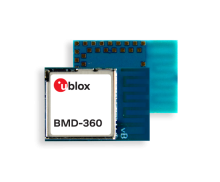
BMD-360 (open CPU)
独立蓝牙 5.1 低功耗模块
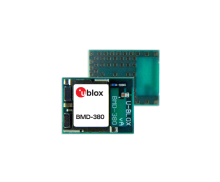
BMD-380(开放式 CPU)
Stand-alone 低功耗蓝牙 5.1 模块
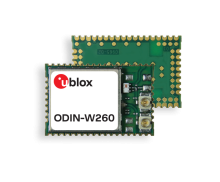
ODIN-W2 系列 (u-connect)
内置 Wi-Fi 和蓝牙的独立物联网网关模块

JODY-W2 系列
内置 Wi-Fi 和蓝牙的 Host-based 多无线电模块